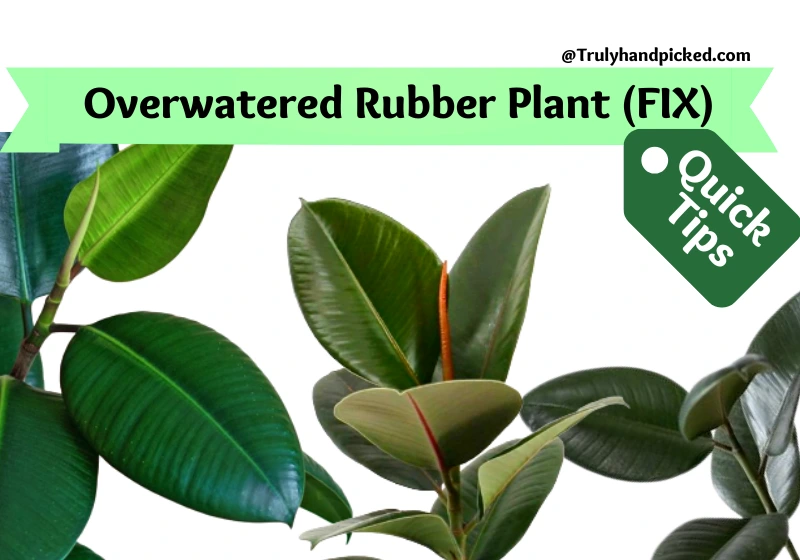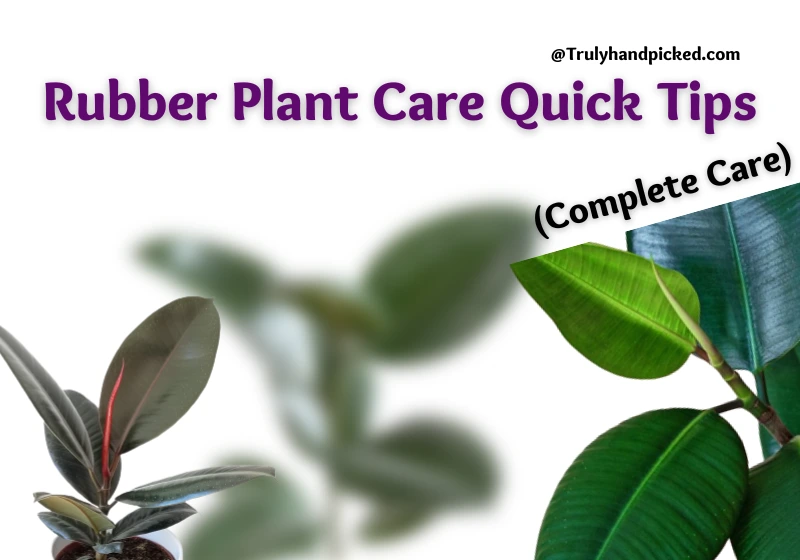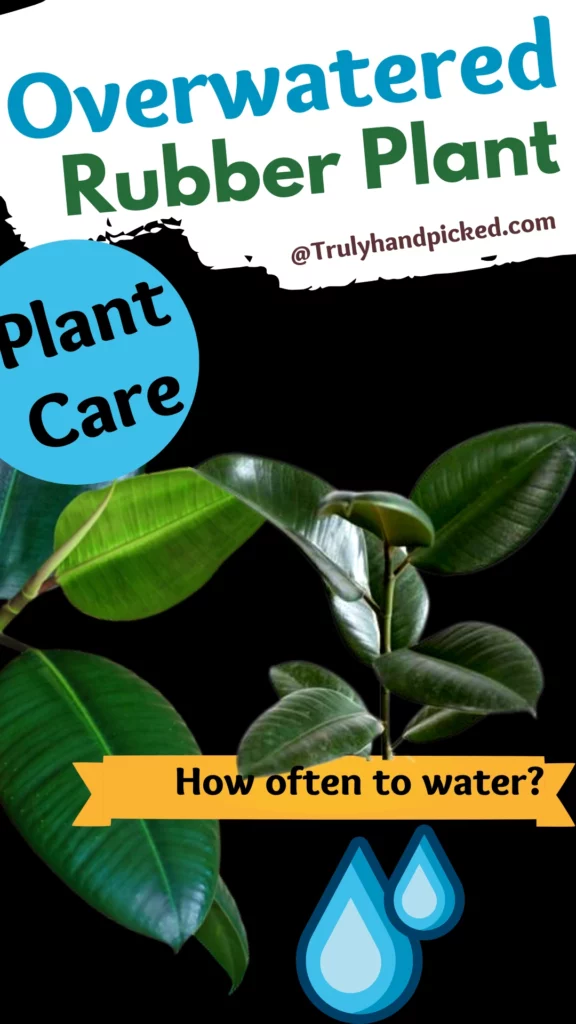It is definitely a great choice to cultivate a rubber plant to embellish your home interior with greens. However, sometimes, any negligence in your caring regimen could bring an unpleasant outcome to your plant.
Overwatering is one of the most emblematic causes that could kill a rubber plant within a few days. If you plan to grow a rubber plant indoors, try to be very particular about its watering methods.
Remember that extra is more damaging for this plant than less. So, no matter what, a gardener must avoid overwatering a rubber plant in any circumstance.
Here are some probable consequences you may face with an overwatered rubber plant along with their possible remedies-
What Happens If You Have Overwatered a Rubber Plant?
A rubber plant is one of those succulents, which don’t need much water to thrive well. consequently, it will start having issues, when you water them more than their actual need. Some common problems a rubber plant could have due to overwatered are, as follows-
Soggy Soil:
If you water your rubber plant more than its actual requirement, this will obstruct the soil for a long. Later, that excessive water makes the soil soggy or water-logged shortly. It will suffocate the root system of your plant for sure.
Root Rot:
Soggy or water-logged soil often initiates unhealthy roots and later root rot in a rubber plant. To keep the roots vigorous, you must maintain well-drained and moderately moist soil that should never feel soggy.
Yellow Leaves:
If you don’t stop overwatering your rubber plant, its leaves will soon lose their color and eventually turn yellow. The overwatered rubber plant won’t perform the photosynthesis process properly and thus lost its deep green shade gradually.
Brown Tips on the Leaves:
Brown spot is one more troubleshooting issue you may face with a growing rubber plant for overwatering. This problem happens when you keep your plant waterlogged for a longer period due to improper drainage as well as overwatering.
Curly Leaves:
Curly leaves could appear when you let the root submerge in the water all the time without letting it dry once. That’s why experts always suggest stopping overwatering your rubber plant and letting the soil dry once every few whiles.
Dropping Leaves:
Rubber plants are drought-resistant and thus, couldn’t stand overwatering anyhow. If you don’t allow it to get dry between the watering session, it will start dropping leaves within a month. Sometimes, keeping the plant dehydrated could also instate drooping leaves in a rubber plant.
Bacterial or Fungal Infestation:
It is superfluous to say that soggy or over-moist soil often brings some kinds of fungal or bacterial diseases in the soil. Water-logged soil couldn’t get enough sunlight and thus, it is possible to get infested by such mycological issues shortly.
Dying Plant:
Above all this overwatered issue could kill your rubber plant entirely within a couple of months. So, try to be attentive to the right water needs of your indoor rubber plant if you want to save it from failing at such a juvenile stage.
How to Save An Overwatered Rubber Plant:
To save a problematic or dying rubber plant, try these smart hacks attentively-
- Stop watering your plant immediately. Let the soil take a breath for a while before starting to water your rubber plant again. It won’t be wrong if you stop watering for 2-3 weeks after detecting the overwatering issue.
- Bring the planter under direct sunlight. Sunlight helps in absorbing extra water from the soil soon. Try to let the rubber plant soak under open and direct sunlight for 6-8 hours a day.
- Change the planter by repotting it. Repotting or replantation will help you to get rid of water-logged soil at once. This will also aid the roots of your rubber plant to grow in a fresh set of growing mediums.
- Make sure the new pot has a perfect drainage system. Using a well-drained growing medium or potting mix is also essential here. Try to prepare a mix combining perlite, coarse sand, pine bark, and peat moss in equal amounts to give it the best growing medium.
- After the replantation, water your plant thoroughly. Since then, reduce your watering method and water only when the soil turns completely dry from the top. You can try once in 15-20 days watering schedule for the best result.
- Consider the weather before finalizing the watering methods. The rubber plant is drought-tolerant and thus, doesn’t need much water during high-humid weather. So, try to less water your rubber plant during winter and monsoon days.
- Be particular about the amount and timing of watering. According to expert gardeners, once a month or once every 2 days is good for watering your fully grown rubber plant. On the contrary, once every 2-3 months is good during winter, autumn, and rainy seasons.
- Dispose of any discolored leaves instantly after controlling the overwatering issue. This will save your plant from having yellow or brown leaves any further. Don’t forget to use only sterilized garden tools to prune or trim down the infected leaves from your rubber plant.
- Place your rubber plant in a moderate to fully warm climate. To keep your plant, safe from over-moistening issues, maintain the growing temperature between 60° F to 80° F in your room.
- Finally, consider underwater than overwater in growing a rubber plant. You must not forget that overwater is more hampering in a rubber plant than underwatering. So, it won’t be a problem if you forget your plant once or twice a month. But, never water it more than once a month ever, if you want to avoid these overwatering issues from your rubber plant entirely.
So, these are some imperative facts you should know about the overwatering issues of a rubber plant to get the healthiest form of it.
How Often and When to Water Your Rubber Plants
If you desire to save your rubber plant from this dangerous issue of overwatering, try to follow some expert watering methods accordingly-
- Water your rubber plant only when it seems thirsty
- Let the soil dry fully between watering
- Reduce the watering, if you find that the weather has high humidity
- Choose to water your rubber plant from below to the top
- Use only distilled or filtered water
- Water your plant in the morning or at noon
- Apply water to a rubber plant with 1-2 inches deep watering
- And try to follow a once or twice a month watering schedule consistently
Follow these hacks to keep the leaves of a rubber plant healthy, firm, holding up well, and glossy with a waxy quoting.
Can A Rubber Plant Survive from Overwatering?
If your rubber plant shows overwatering and you recognize it well in time, you can revive it. Due to being a forgiving plant, it is quite simple to save a rubber plant from its overwatering issue.
Just try to stop and amend the issue of overwatering as soon as you find it out. So, if you wondered whether a drying rubber plant could be saved from its overwatering issue, the answer is yes, of course! Only make sure that you distinguish and reverse the schedule in time.

